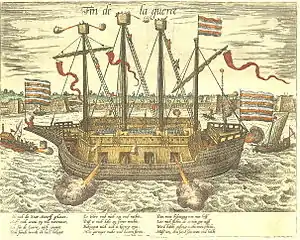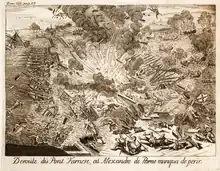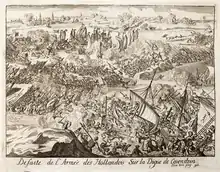Fall of Antwerp
The Fall of Antwerp on 17 August 1585 took place during the Eighty Years' War, after a siege lasting over a year from July 1584 until August 1585. The city of Antwerp was the focal point of the Protestant-dominated Dutch Revolt, but was forced to surrender to the Spanish forces. Under the terms agreed, all Protestants were given four years to settle their affairs and leave the city. Many migrated north, especially to Amsterdam, which became the capital of the Dutch Republic. Apart from losing a high proportion of its mercantile population, Antwerp's trade suffered for two centuries as Dutch forts blockaded the River Scheldt up to 1795.
| Siege of Antwerp | |||||||
|---|---|---|---|---|---|---|---|
| Part of the Eighty Years' War | |||||||
 Dutch Finis Belli, a fortified ship meant to break the Spanish blockade. | |||||||
| |||||||
| Belligerents | |||||||
|
Supported by: |
| ||||||
| Commanders and leaders | |||||||
|
|
| ||||||
| Strength | |||||||
|
80,000 men (Inhabitants) | 40,000 men | ||||||
| Casualties and losses | |||||||
| 8,000 | Unknown | ||||||
Background
At the time Antwerp, in modern Belgium, was not only the largest Dutch city, but was also the cultural, economic, and financial centre of the Seventeen Provinces and of north-western Europe. On 4 November 1576, unpaid Spanish soldiery mutinied: they plundered and burnt the city during what was called the Spanish Fury. Thousands of citizens were massacred and hundreds of houses were burnt down. As a result, Antwerp became even more engaged in the rebellion against the rule of Habsburg Spain. The city joined the Union of Utrecht (1579) and became the capital of the Dutch Revolt, which no longer was merely a Protestant rebellion but had become a revolt of all Dutch provinces.
Relieved from the great battles with the Ottomans in the Mediterranean, Philip II of Spain turned his attention back to the uprising in the Low Countries and in 1579 sent Alessandro Farnese, Duke of Parma, to head his army in Flanders to regain control over Flanders, Brabant, and the United Provinces. When the siege of Antwerp began (1584) most of the County of Flanders and the Duchy of Brabant, including Brussels, had been recaptured in the preceding year. The army of Flanders had been reinforced in the previous years, both in quantity and quality, and in 1585 it had 61,000 men under arms.
The siege begins


During the recapture of Flanders and Brabant, Farnese improved the logistics of the Spanish army in Flanders by further investing in what is dubbed the "Spanish Route." It was a main road leading north from Habsburg holdings in Northern Italy into the Low Countries, protected by forts built at strategic intervals, to provide the army with a reliable flow of supplies. When the siege of Antwerp began Parma's army was well supplied. The first stage of the siege saw encirclement lines constructed around Antwerp and forts built along the Scheldt estuary.
The second stage consisted of commencing a long siege of Antwerp and constructing a bridge across the Scheldt, effectively closing off the city's waterways. The bridge, a unique feat of siege engineering at the time, consisted of a strong fort (reinforced with cannons) on each side of the Scheldt with a bridge of connected pontoons (paintings show sizable rowing boats) running between them. (This bridge is believed to have been 730m long.)
In response to the closure of the Scheldt by this bridge, the Dutch flooded the lowlands adjacent to the Scheldt, effectively submerging most roads in scattered areas and leaving Spanish forts either flooded or isolated on small islands. Despite the Dutch using these floodplains to try to regain control over the Scheldt (using low draft oar and sail boats with small cannon emplacements on them), the Spanish position largely held firm, as many of the Spanish forts had been equipped with cannon and high quality troops. Several attempts were made by the Dutch to steer "fire ships" into the Spanish pontoon bridge, but the troops stationed in the adjacent forts managed to push them off course with pikes – though with heavy loss of life when the fire ships exploded. 800 Spaniards are said to have been killed, Caspar de Robles being one of the casualties.
At one time, the rebels sent the Finis Belli ("End of War"), a huge floating platform into which they put great hope, against the bridge, but the mission failed. In the end the Dutch abandoned their efforts, considering Antwerp a lost cause.
Surrender
On 17 August 1585, Antwerp surrendered. After the siege, the Dutch fleet on the river Scheldt was kept in position, blocking the city's access to the sea and cutting it off from international trade. Parma stationed experienced Castilian troops within Antwerp to make sure the city would not fall into enemy hands. The moderateness of Parma's demands and the behaviour of his troops were a complete surprise given the bloodiness of the siege and the rampage of 1576. Parma issued strict orders not to sack the city. The Spanish troops behaved impeccably, and Antwerp's Protestant population was given four years to settle their affairs before leaving.[1]
Some returned to Roman Catholicism but many moved north and ended what had been a golden century for the city. Of the pre-siege population of 100,000 people, only 40,000 remained. Many of Antwerp's skilled tradesmen were included in the Protestant migration to the north, laying the commercial foundation for the subsequent "Dutch Golden Age" of the northern United Provinces. Although the city returned to prosperity, the Dutch blockade of commercial shipping in the Scheldt remained in place and prevented the city recovering its former glory. The blockade was maintained for the next two centuries and was an important and traumatic element in the history of relations between the Netherlands and what was to become Belgium.
References
- Alfons K. L. Thijs, Van Geuzenstad tot katholiek bolwerk: Maatschappelijke betekenis van de kerk in contrareformatorisch Antwerpen (Antwerp, 1990), p. 102.
Further reading
- Geyl, Pieter. (1932), The Revolt of the Netherlands, 1555–1609.
- Israel, Jonathan I. (1998), The Dutch Republic. Its Rise, Greatness, and Fall 1477–1806, Clarendon Press, Oxford, pp 216–19 ISBN 9780198207344
- Parker, Geoffrey (2nd ed. 1990), The Dutch revolt, Penguin books, London ISBN 9780140137125
External links
- "Asedio de Amberes, 1584–85", geocities.com; accessed 26 December 2014. (in Spanish)